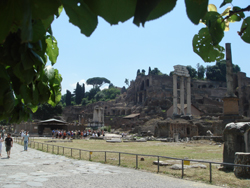11th July 2009

Carved into the cliff itself (rather than onto the clifff face) the Grand Buddha face alone is clearly visible standing at the top - the cliff from which it is carved concealing the rest below. Looking across the face, to the other side, other visitors are dwarved by the scale of the face - the ears alone measure over 7 meters in height. Red sandstone is highly vulnerable to the elements and so an elaborate drainage system was designed and incorporated into the statue - with being set into the cliff has helped preserve the Giant Buddha for over 1,000 years.

Numerous carvings line the cliff face on the way down - ensuring that the steps, in themselves, are a worthwhile visit. Erosion and exposure to elements over a millenia has taken its toll on the carvings, several scences and charecters are clearly identifiable - such as the temple scene pictured.
Descending further, progressivly slower with each step, more of the Giant Buddha becomes visible. Pilgrims take their time to admire this wonderous statue.

It's difficult to imagine how the statue was built in the first place - over 1,000 years ago. Although, on the cliff face there is evidence of what could have been scaffholding placed here during the construction and or to protect the Buddha from the elements.
The journey to the top was, surprisingly, easier than the journey down. Or perhaps we were expecting it to be harder. Either way it seemed easier. Luckily we had arrived early in the morning - before the crowds. Many arrived after us and the pilgrims visit the crimson and yellow Temple before descending to see the Giant Buddha so the queues had reached fever pitch. We returned to the front of the complex through the crimson and yellow coloured temple which sits above the Giant Buddha.

It's kinda hard to express just how giant the Giant Buddha in writing. So I'm gonna stop. The scale of the Buddha is best experienced by both walking to his feet and taking the boat out to the river.
Go forth and see for yourself.







